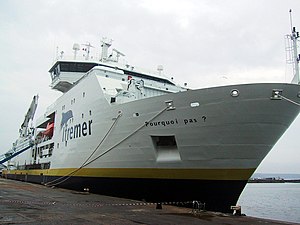French ship Pourquoi Pas? (2005)
 Pourquoi Pas ? in Brest after her delivery
| |
| History | |
|---|---|
| Namesake | Pourquoi Pas ? IV |
| Launched | 14 October 2004 |
| Identification |
|
| Status | Active as of 2025 |
| General characteristics | |
| Class and type | research vessel |
| Displacement | 6600 tonnes |
| Length | 107 m (351 ft) |
| Beam | 20 m (66 ft) |
| Draught | 6.9 m (23 ft) |
| Propulsion | Diesel-electric with a Class II dynamic positioning system. |
| Speed | 14.5 knots (26.9 km/h; 16.7 mph) |
| Endurance | 64 days at 11 knots |
| Boats & landing craft carried | ROV |
| Capacity | 1000 m² laboratory, 40 scientists |
| Complement | 18 to 33 men |
| Sensors and processing systems |
|
Pourquoi Pas ? (English: Why Not?) is a research vessel built in Saint-Nazaire, France by Alstom Marine[1] for IFREMER and the French Navy[2] and primarily used by Service hydrographique et océanographique de la Marine (SHOM).[3] Pourquoi Pas ? was ordered in December 2002 and completed in July 2005.[4] The 66 million euro cost was financed by IFREMER (55%) and the French Navy (45%).[5]
Name
[edit]She is named after explorer Jean-Baptiste Charcot's famous ship.[4] A space is required immediately before a question mark in French orthography, and accordingly, in French Pourquoi Pas ? is the correct way to write the name.
Use
[edit]Pourquoi Pas ? is used on average 130 days per year by the French Navy and the rest by IFREMER.[3] It was designed for hydrography, geoscience, and physical, chemical, and biological oceanography, as well as to launch small submarines such as the crewed submersible Nautile and the ROV Victor 6000.[4] Since 2010, the ship has been used in a series of annual cruises MoMARSAT maintaining the EMSO-Azores observatory at the Lucky Strike hydrothermal field.[6][7]
Notable missions
[edit]Pourquoi Pas ? has been used for the 2007 deployment and connection operations for the ANTARES neutrino telescope.[8] In 2008, Pourquoi Pas ? was used for the initial testing and operations of the PERISCOP, a pressurized deep sea fish recovery device.[9] In June 2009, she was used to assist the recovery of Air France Flight 447.[10][11] In November 2020, the ship was used to find the wreckage of an Aquilon fighter jet that had disappeared in June 1960.[12] In April 2024, scientists on board the Pourquoi Pas ? discovered 6 new seamounts in the North Pacific off Mexico.[13]
External links
[edit]- (in French) Pourquoi-Pas ? site at IFREMER
- (in French) Netmarine
- BBC article about the PERISCOP

References
[edit]- ^ "Detailed characteristics". French oceanographic fleet. Retrieved 2025-02-13.
- ^ "Pourquoi pas ?". French oceanographic fleet. Retrieved 2025-02-13.
- ^ a b "Pourquoi pas ?". Flotte océanographique française opérée par l'Ifremer (in French). Retrieved 2025-02-13.
- ^ a b c Lefort, Olivier; Nokin, Marc (2006-01-01). "Le Pourquoi pas ? navire océanographique innovant".
{{cite journal}}: Cite journal requires|journal=(help) - ^ "Ifremer: Le Pourquoi Pas? repart en essais". December 6, 2005.
- ^ "MoMARSAT : Monitoring the Mid-Atlantic Ridge". campagnes.flotteoceanographique.fr (in French). Retrieved 2025-02-13.
- ^ "Maintenance cruises". EMSO France. Retrieved 2025-02-13.
- ^ YU, Pei (2007-12-07). "From 5 to 10 lines A major step toward completion – ANTARES". Retrieved 2025-02-13.
- ^ Shillito, B.; Hamel, G.; Duchi, C.; Cottin, D.; Sarrazin, J.; Sarradin, P.-M.; Ravaux, J.; Gaill, F. (July 2008). "Live capture of megafauna from 2300m depth, using a newly designed Pressurized Recovery Device". Deep Sea Research Part I: Oceanographic Research Papers. 55 (7): 881–889. doi:10.1016/j.dsr.2008.03.010.
- ^ "Boites noires du Vol AF 447. Le Pourquoi Pas sonde l'océan". Le Télégramme (in French). 2009-07-30. Retrieved 2025-02-13.
- ^ archives.defense.gouv.fr https://archives.defense.gouv.fr/operations/afrique/afrique-de-l-ouest/elements-francais-au-senegal/breves/25-06-09-af-447-le-point-sur-les-recherches.html. Retrieved 2025-02-13.
{{cite web}}: Missing or empty|title=(help) - ^ Charpentreau, Clément (2020-11-27). "Divers find missing wreck of SE.203 Aquilon fighter jet - AeroTime". www.aerotime.aero. Retrieved 2025-02-13.
- ^ "Six new seamounts discovered in the Pacific". Ifremer. Retrieved 2025-02-13.
